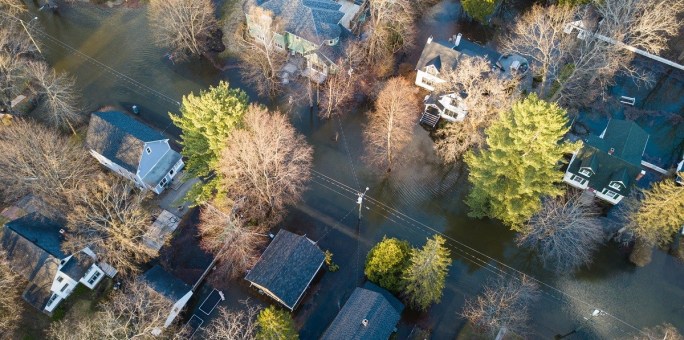
The most common natural disaster in the United States, according to Ready.gov, is flooding. But, even though they’re regular occurrences, floods — and the situations that lead to them — aren’t always readily understood. Here are the basics you need to know about floods, and some factors that may increase the risk of one happening in your area.
What Is a Flood?
Simply put, a flood is when water overwhelms an area of land that is normally dry. When the amount of water is more than a natural or man-made drainage system can handle, flooding can then occur, says the U.S. Climate Resilience Toolkit.
A flood may occur suddenly, or happen gradually — regardless, any flood has the potential to cause injuries, disruptions in utility services and transportation or property damage. In fact, just one inch of flood water in a home can cause $25,000, or more, in damage, according to FloodSmart.gov.
What Increases the Risk of Flooding?
A flood can happen at any time, but there are some situations that particularly increase the likelihood of experiencing a flood, according to the National Weather Service:
- Tropical systems: Tropical storms and hurricanes can generate torrential rains and strong winds that produce storm surges, which can flood coastal and inland areas.
- Heavy rainfall: Intense storms can drop large amounts of rainfall that results in a buildup of water. This can cause flash flooding that overwhelms rivers and dry land.
- Snowmelt: Ready.gov notes that a cubic foot of snow consists of multiple gallons of water. As freezing temperatures rise and snow begins to melt, the ground may not be able to absorb the water due to being frozen or oversaturated.
- Ice and debris jams: Pieces of ice or debris that travel down rivers or streams can create jams that cause water to overflow upstream. Once the jam loosens and breaks apart, it can cause downstream flooding.
- Compromised levees or dams: If a dam or levee fails, or if the water level rises and spills over the top of the structure, flooding can occur.
Where Do Floods Occur?
A flood can happen anywhere, according to the National Severe Storms Laboratory. But, the agency says there are some areas that may be more vulnerable to floods than others:
- Dense urban areas: These areas are at risk for flash floods because roads, sidewalks and other paved elements can’t soak up rainwater, which increases water runoff. A heavy downpour can also inundate storm drains and result in a flood, creating unsafe conditions for underground parking garages or underpasses.
- Areas along or near rivers: Heavy rains can cause flash floods near rivers, which can be worsened by a dam or levee failure. Mountains can also contribute to the quick rise of streams or rivers as water rapidly flows downhill.
- Canyons and wildfire burn areas: These areas can be more likely to flood due to dry soil or limited vegetation that prevents heavy rainfall from soaking in.
The bottom line is that it’s important to understand that a flood can happen anywhere. Consider signing up for local community alerts and do what you can to prepare, which, among other things, may include purchasing a flood insurance policy.
Source: https://al.st/2WTUiRM

